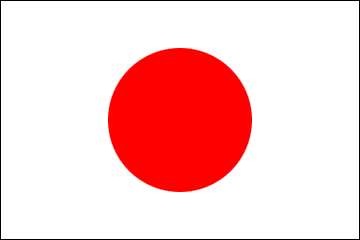October 14, 2021: Visit to the exhibition of the Slovak Suiseki Association
2021/12/8
I visited the exhibition of the Slovak Suiseki Association, which took place in Komárno, a town about 100 km downstream of the Danube River.
Suiseki is the art of arranging natural stones on a pedestal. They can often be found right on the banks of rivers. You need to use your imagination to find an image of a landscape, a character or even an event in them and appreciate its beauty. I'm ashamed to admit that I didn't really know what suiseki was. However, when I visited the bonsai exhibition in Levoča in September, I met Mr. Vladimír Kamocsai, President of the Slovak Suiseki Association, who informed me about the exhibition in Komárno. I visited such an exhibition for the first time. By the way, the President speaks fluent Japanese. He seems to have learned it all by himself and I remember being very surprised by that on our first meeting.
I was pleased to see the exhibited suiseki with members of the association, including President Kamocsai, who introduced me each of the exhibits. It was very interesting. I learned that in order to find suiseki in nature, you must take a number of collecting trips not only in Slovakia, but also in the Czech Republic and Hungary. It seems that it takes a lot of patience to hit a stone with a "it's him" tag that has the right shape and color. It is equally difficult to subsequently produce a pedestal on which the stones found are placed. It is not uncommon for this to take 2 or 3 months. The pedestals are handmade originals that must fully match the amorphous natural stone. I was impressed when the president's wife laughed, "I'm home alone forever, guarding our house."
At first glance, I felt that limestone, especially limestone of unusual colors such as green and ultramarine, is valued the most. Due to weathering and the action of water, a unique shape or pattern can be found in the case of this stone. Among the members of the association is a geologist who is looking for suiseki in addition to his daily work in the field and can professionally analyze the stones found. Each member seems to have his / her own way of enjoying the art of suiseki.
I was surprised how many Slovaks are engaged in activities related to Japanese culture, such as bonsai, suiseki, go or shogi. I think there are more foreigners who are deeply interested in Japanese culture than we Japanese think. Therefore, I would like to continue to deepen relations with members of individual interest organizations or associations.
Suiseki is the art of arranging natural stones on a pedestal. They can often be found right on the banks of rivers. You need to use your imagination to find an image of a landscape, a character or even an event in them and appreciate its beauty. I'm ashamed to admit that I didn't really know what suiseki was. However, when I visited the bonsai exhibition in Levoča in September, I met Mr. Vladimír Kamocsai, President of the Slovak Suiseki Association, who informed me about the exhibition in Komárno. I visited such an exhibition for the first time. By the way, the President speaks fluent Japanese. He seems to have learned it all by himself and I remember being very surprised by that on our first meeting.
I was pleased to see the exhibited suiseki with members of the association, including President Kamocsai, who introduced me each of the exhibits. It was very interesting. I learned that in order to find suiseki in nature, you must take a number of collecting trips not only in Slovakia, but also in the Czech Republic and Hungary. It seems that it takes a lot of patience to hit a stone with a "it's him" tag that has the right shape and color. It is equally difficult to subsequently produce a pedestal on which the stones found are placed. It is not uncommon for this to take 2 or 3 months. The pedestals are handmade originals that must fully match the amorphous natural stone. I was impressed when the president's wife laughed, "I'm home alone forever, guarding our house."
At first glance, I felt that limestone, especially limestone of unusual colors such as green and ultramarine, is valued the most. Due to weathering and the action of water, a unique shape or pattern can be found in the case of this stone. Among the members of the association is a geologist who is looking for suiseki in addition to his daily work in the field and can professionally analyze the stones found. Each member seems to have his / her own way of enjoying the art of suiseki.
I was surprised how many Slovaks are engaged in activities related to Japanese culture, such as bonsai, suiseki, go or shogi. I think there are more foreigners who are deeply interested in Japanese culture than we Japanese think. Therefore, I would like to continue to deepen relations with members of individual interest organizations or associations.
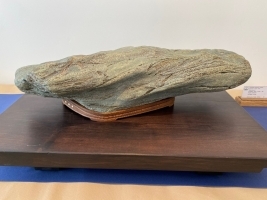 |
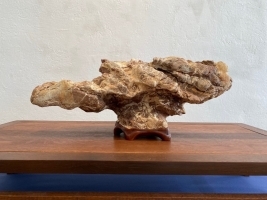 |
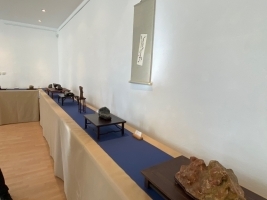 |
| The work of V. Kamocsai, President of SAS | Suiseki entitled "Clouds" | |
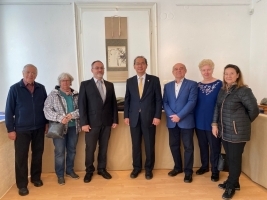 |
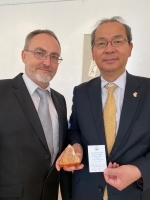 |
|
| With members of the Slovak Suiseki Association |
With Vladimir Kamocsai, Chairman SAS, who gave me a nice present |
